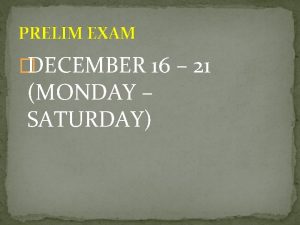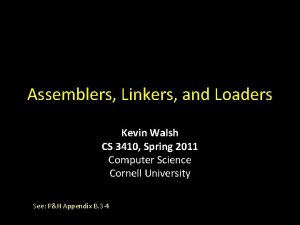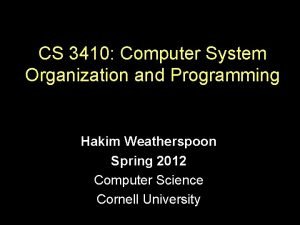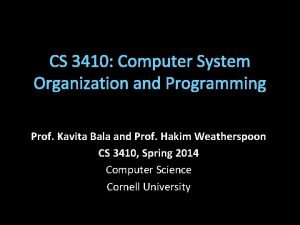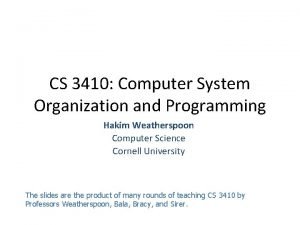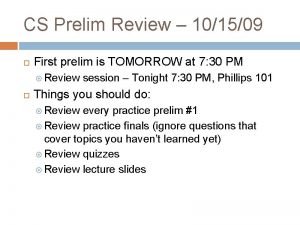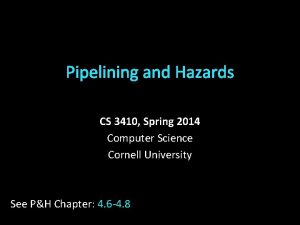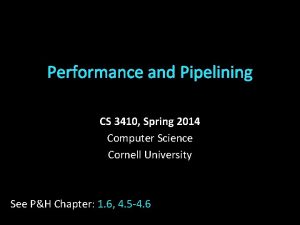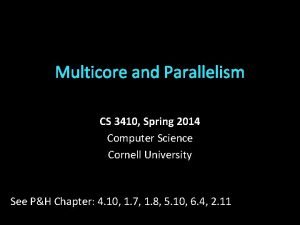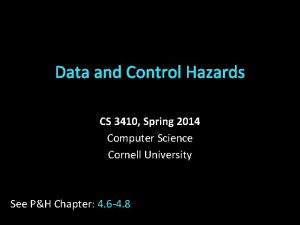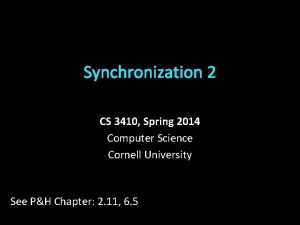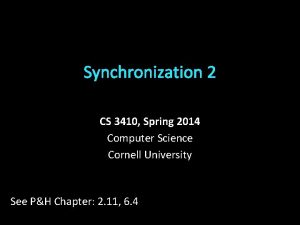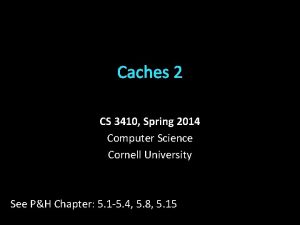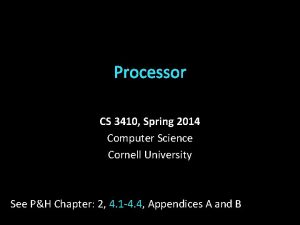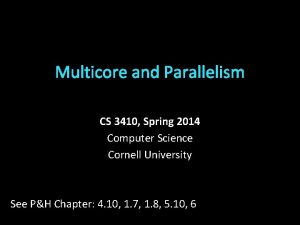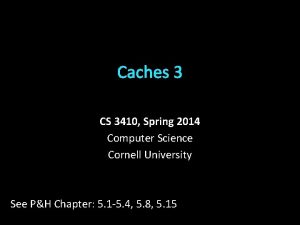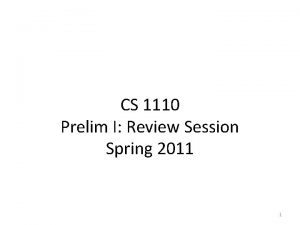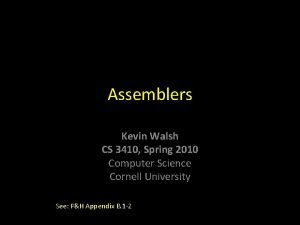CS 3410 Spring 2014 Prelim 2 Review Prelim





















![Concurrency(Homework 2 Q 8) c[0]? A: B: =>0 LW $t 0, 0($s 0) ADDIU Concurrency(Homework 2 Q 8) c[0]? A: B: =>0 LW $t 0, 0($s 0) ADDIU](https://slidetodoc.com/presentation_image_h2/9429708489b6bc006f355453222d2e71/image-22.jpg)

- Slides: 23

CS 3410 - Spring 2014 Prelim 2 Review

Prelim 2 Coverage • • Calling Conventions Linkers Caches Virtual Memory Traps Multicore Architectures Synchronization

Calling Convention • Prelim 2, 2013 sp, Q 5: – Translate the following C code to MIPS assembly: int foo(int a, int b, int c, int d, int e) { int tmp = (a|b) – (d&e); int q = littlefoo(tmp); int z = bigfoo(q, tmp, a, b, c); return tmp + q – z; }

Calling Convention (cont. ) int foo(int a, int b, int c, int d, int e) { int tmp = (a|b) – (d&e); int q = littlefoo(tmp); int z = bigfoo(q, tmp, a, b, c); return tmp + q – z; } Question 1: how many caller/callee save registers for which variables? Callee save (need the original value after a function call): a, b, c, tmp, q Caller save (do not need to preserve in a function call): d ($a 3), e, z ($v 0) Question 2: how many outgoing arguments we should leave space for? 5: bigfoo(q, tmp, a, b, c) Question 3: what is the stack frame size? ra + fp + 5 callee-save + 5 outgoing args = 12 words = 48 bytes

Calling Convention (cont. ) int foo(int a, int b, int c, int d, int e) { int tmp = (a|b) – (d&e); int q = littlefoo(tmp); int z = bigfoo(q, tmp, a, b, c); return tmp + q – z; } #prolog ADDIU $sp, SW $ra, 44($sp) SW $fp, 40($sp) SW $s 0, 36($sp) SW $s 1, 32($sp) SW $s 2, 28($sp) SW $s 3, 24($sp) SW $s 4, 20($sp) ADDIU $fp, $sp, -48 # (== 5 x outgoing args, 5 x $sxx, $ra, $fp) # store, # store, 44 then then $s 0 $s 1 $s 2 $s 3 $s 4 = = = a b c tmp = (a|b) – (d&e) q = littlefoo(tmp)

Calling Convention (cont. ) int foo(int a, int b, int c, int d, int e) { int tmp = (a|b) – (d&e); int q = littlefoo(tmp); int z = bigfoo(q, tmp, a, b, c); return tmp + q – z; } #Initializing local variables MOVE $s 0, $a 0 MOVE $s 1, $a 1 MOVE $s 2, $a 2 OR $t 0, $s 1 # $t 0 = (a|b) LW $t 1, 64($sp) # 64 = 48(own stack) + 16(5 th arg in parent) AND $t 1, $a 3, $t 1 # $t 1 = (d&e) SUB $s 3, $t 0, $t 1 # $s 3 = tmp = (a|b) – (d&e)

Calling Convention (cont. ) int foo(int a, int b, int c, int d, int e) { int tmp = (a|b) – (d&e); int q = littlefoo(tmp); int z = bigfoo(q, tmp, a, b, c); return tmp + q – z; } #Calling littlefoo MOVE $a 0, $s 3 # $a 0 = tmp JAL littlefoo NOP #Calling bigfoo MOVE $s 4, $v 0 # $s 4 = q = littlefoo(tmp) MOVE $a 0, $s 4 # $a 0 = $s 4 = q MOVE $a 1, $s 3 # $a 1 = $s 3 = tmp MOVE $a 2, $s 0 # $a 2 = $s 0 = a MOVE $a 3, $s 2 # $a 3 = $s 1 = b SW $s 2, 16($sp) # 5 th arg = $s 2 = c JAL bigfoo # bigfoo(q, tmp, a, b, c) NOP

Calling Convention (cont. ) int foo(int a, int b, int c, int d, int e) { int tmp = (a|b) – (d&e); int q = littlefoo(tmp); int z = bigfoo(q, tmp, a, b, c); return tmp + q – z; } #Generating return value ADD $t 0, $s 3, $s 4 # $t 0 = tmp + q SUB $v 0, $t 0, $v 0 # $v 0 = $t 0 – z = (tmp + q) – z #epilog LW $s 4, 20($sp) LW $s 3, 24($sp) LW $s 2, 28($sp) LW $s 1, 32($sp) LW $s 0, 36($sp) LW $fp, 40($sp) LW $ra, 44($sp) ADDIU $sp, 48 JR $ra NOP

Linkers and Program Layout • Prelim 2, 2012 sp, Q 2 b: – The global pointer, $gp, is usually initialized to the middle of the global data segment. Why the middle? Load and store instructions use signed offsets. Having $gp point to the middle of the data segment allows a full 2^16 byte range of memory to be accessed using positive and negative offsets from $gp.

Linkers and Program Layout • Prelim 2, 2012 sp, Q 2 c: – Bob links his Hello World program against 9001 static libraries. Amazingly, this works without any collisions. Why? The linker chooses addresses for each library and fills in all the absolute addresses in each with the numbers that it chose.

Caches • Prelim 2, 2013 sp, Q 4: – Assume that we have a byte-addressed 32 -bit processor with 32 -bit words (i. e. a word is 4 bytes). Assume further that we have a cache consisting of eight 16 -byte lines

Caches (cont. ) • How many bits are needed for the tag, index, and offset for the following cache architectures? – Direct Mapped • Tag: 25, Index: 3, Offset: 4 – 2 -way Set Associative • Tag: 26, Index: 2, Offset: 4 – 4 -way Set Associative • Tag: 27, Index: 1, Offset: 4 – Fully Associative • Tag: 28, Index: 0, Offset: 4 • Offset is only determined by the size of the cache line. • Index is determined by how caches are organized. • Tag = 32 – index - offset

Caches (cont. ) • For each access and for each specified cache organization, indicate whethere is a cache hit, a cold (compulsory) miss, conflict miss, or capacity miss.


Virtual Memory (2012 Prelim 3, Q 4) Virtual Address: 32 -bit Page Size: 16 k. B Single level page table Each page table entry is 4 bytes. Each process segment requires a separate physical page. Bits for page Offset? Bits for page table index? Physical memory? Each segment size < one page size 4*16 k. B = 64 k. B 2^18 (PTE’s) * 4 bytes = 1 MB Total: 64 k. B + 1 MB 16 k. B = 2^14 B So we need 14 bits Stack 8 k. B Heap 8 k. B Data 8 k. B Code 8 k. B 32 -14 bits = 18 bits Memory layout of a single process

Virtual Memory (2012 Prelim 3, Q 4) Two level page table Assume there are enough page table entries to fill a second-level page table. (which means every entry in a second level page table will be used) Bits for page offset? 14 bits Bits for second level page table? 16 k. B/4 B=2^12 So we need 12 bits Bits for page directory? 32 -14 -12 bits=6 bits Physical memory(each process segment requires a separate second-level page table)? 1 st: 2^6 * 4 B < 2^14 B=> 16 k. B 2 nd: 4 * 16 k. B Pages: 4 * 16 k. B Total: 16 k. B+4*16 k. B ……

Syscall User Program Kernel main(){ … syscall(arg 1, arg 2); … } syscall(arg 1, arg 2){ do operation } User Stub Kernel Stub syscall(arg 1, arg 2){ trap return } handler(){ copy arguments from user memory check arguments syscall(arg 1, arg 2); copy return value into user memory Hardware Trap Return

Exceptions On an interrupt or exception CPU saves PC of exception instruction (EPC) CPU Saves cause of the interrupt/privilege (Cause register) Switches the sp to the kernel stack Saves the old (user) SP value Saves the old (user) PC value Saves the old privilege mode Sets the new privilege mode to 1 Sets the new PC to the kernel interrupt/exception handler Kernel interrupt/exception handler handles the event Saves all registers Examines the cause Performs operation required Restores all registers Performs a “return from interrupt” instruction, which restores the privilege mode, SP and PC

Syscall V. S. Exceptions

Concurrency (2012 Prelim 3, Q 5) mutex_lock(&m) operation mutex_unlock(&m) Load-link returns the current value of a memory location, while a subsequent store-conditional to the same memory location will store a new value only if no updates have occurred to that location since the load-link. Together, this implements a lock-free atomic readmodify-write operation. mutex_lock try: LI LL BNEZ SC BEQZ $t 1, $t 0, $t 1, mutex_unlock SW $zero, 0($a 0) 1 0($a 0) try

Concurrency (2012 Prelim 3, Q 5) Critical Section: x = max(x, y) x: global variable, shared; y: local variable &x: $a 1 y: $a 2 Implement critical section using LL/SC without using mutex_lock and mutex_unlock try: LL $t 0, 0($a 1) BGE $t 0, $a 2, next NOP MOVE $t 0, $a 2 next: SC $t 0, 0($a 1) BEQZ $t 0, try NOP
![ConcurrencyHomework 2 Q 8 c0 A B 0 LW t 0 0s 0 ADDIU Concurrency(Homework 2 Q 8) c[0]? A: B: =>0 LW $t 0, 0($s 0) ADDIU](https://slidetodoc.com/presentation_image_h2/9429708489b6bc006f355453222d2e71/image-22.jpg)
Concurrency(Homework 2 Q 8) c[0]? A: B: =>0 LW $t 0, 0($s 0) ADDIU $t 0, 2 SW $t 0, 0($s 0) SW $zero, 0($s 0) B: A: =>2 SW $zero, 0($s 0) LW $t 0, 0($s 0) ADDIU $t 0, 2 SW $t 0, 0($s 0) A: B: A: =>3 LW $t 0, 0($s 0) ADDIU $t 0, 2 SW $zero, 0($s 0) SW $t 0, 0($s 0)

Concurrency(Homework 2 Q 8)
 Prelim schedule cornell
Prelim schedule cornell Prelim midterm finals grading system
Prelim midterm finals grading system Prelim check
Prelim check Hisd calendar
Hisd calendar Cs 3410
Cs 3410 Rfc3410
Rfc3410 Cs 3410 cornell
Cs 3410 cornell Cornell cs 3410
Cornell cs 3410 Cs 3410
Cs 3410 Cs3410
Cs3410 Cs 3410
Cs 3410 Cs 3410
Cs 3410 Four seasons korean movie
Four seasons korean movie Spring summer fall winter seasons
Spring summer fall winter seasons Bp statistical review of world energy 2014
Bp statistical review of world energy 2014 World history final exam study guide
World history final exam study guide World history spring final exam review answers
World history spring final exam review answers Narrative review vs systematic review
Narrative review vs systematic review Traditional and systematic review venn diagram
Traditional and systematic review venn diagram Chapter review motion part a vocabulary review answer key
Chapter review motion part a vocabulary review answer key Narrative review vs systematic review
Narrative review vs systematic review Writ of certiorari ap gov example
Writ of certiorari ap gov example Greek or latin root/affix labor-to work
Greek or latin root/affix labor-to work Ema/448443/2014
Ema/448443/2014

